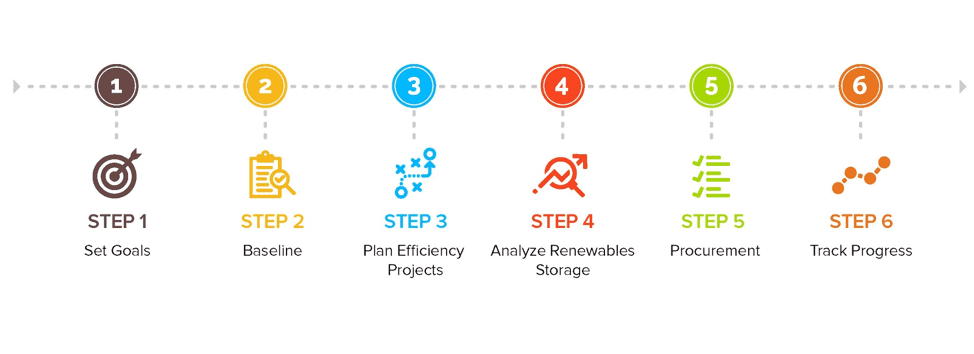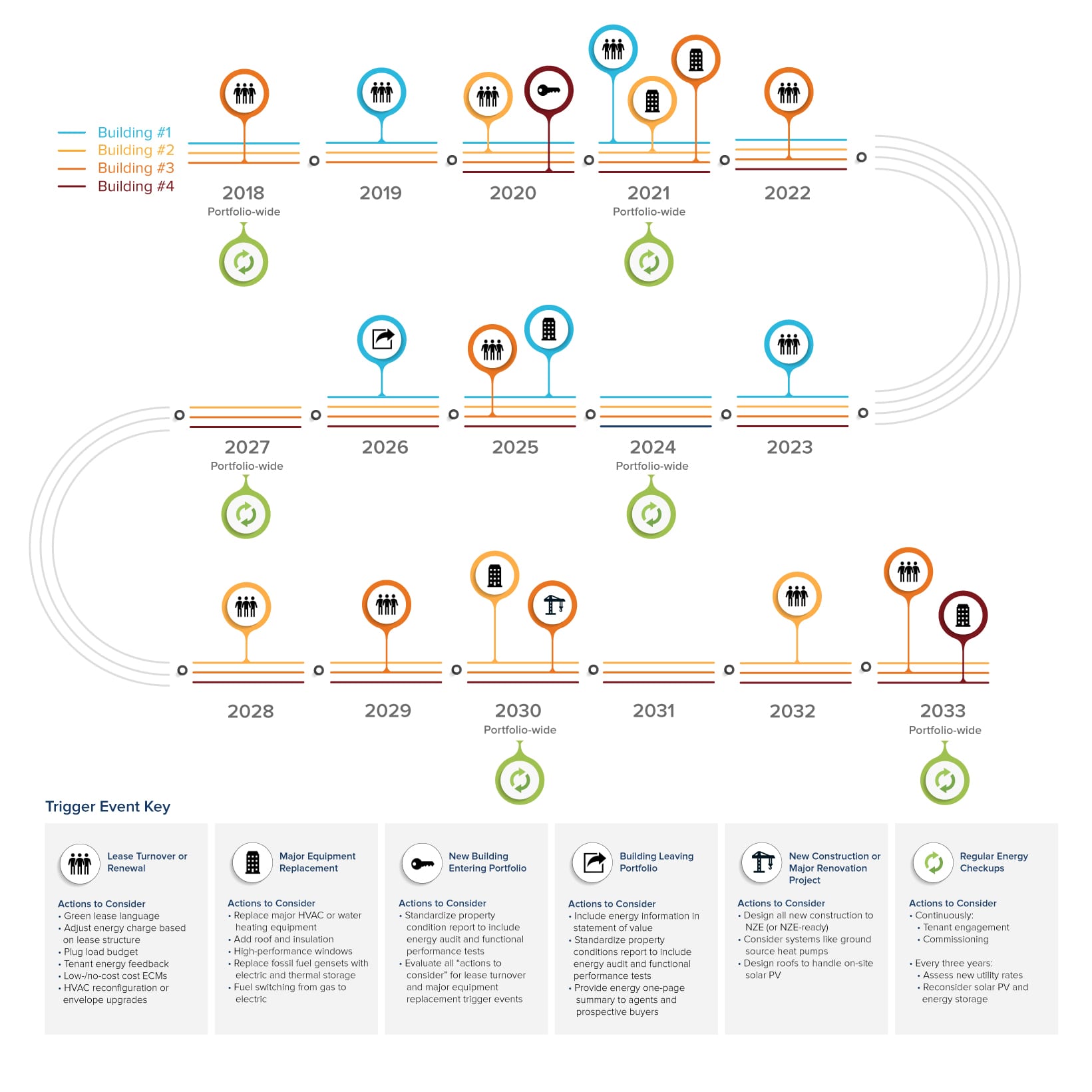Solar Power Plant in modern city,Sustainable Renewable Energy.

Zero Over Time Process Drives Existing Portfolios Toward Net Zero Energy
Net-zero energy (NZE) buildings are gaining interest from building owners, tenants, and landlords alike. RMI’s latest report, in partnership with Urban Land Institute (ULI), Best Practices for Achieving Zero Over Time for Building Portfolios, outlines our zero-over-time (ZOT) approach to help portfolio owners navigate the barriers to achieving net zero energy by providing a roadmap to achieve cost-effective deep energy retrofits over time.
The Problem
Existing commercial buildings consume 36 percent of all electricity in the United States and are responsible for more than $190 billion of energy consumption every year. Existing buildings globally are only receiving energy retrofits at a rate of around 1 percent per year, while a rate of around 3.2 percent per year is required to avoid irreversible climate change and warm the Earth below the two degree increase target by 2040 (as laid out at COP21). The market needs an approach to renovate existing buildings that is both economical and strategically planned, blending short-term requirements with long-term goals. Although achieving net zero energy (NZE) in new buildings is very attainable, renovating an existing building or a portfolio of existing buildings to achieve NZE poses different challenges. The multiple barriers holding back energy retrofits are widespread and well known, and include split incentives, cost of capital, average investment horizon, internal payback hurdles, and the hassle factor.
The Solution: Zero Over Time
A ZOT approach will help portfolio owners navigate these barriers by providing a roadmap to achieve cost-effective deep energy retrofits over time. This approach focuses on long-term planning to deliver a series of cost-effective projects over about 20 years that, together, make changes that amount to zero energy status for the entire portfolio while increasing revenues.
This approach applies not only to portfolios with a net-zero energy goal, but also to existing buildings or portfolios with energy reduction targets. The solution is transferable from one building owner to another, so it supports the value of a long-term plan, regardless of how long a property is held.
Stepping back, we recognize that capital and operations planning is complex and that methodologies vary widely from portfolio to portfolio. The ZOT process provides a useful framework and can be tailored to each application.
Achieving Zero Over Time in Six Steps
Achieving ZOT requires a thoughtful approach, but not an overly complicated one. Industry interviews and case-study analysis informed six steps for achieving net zero energy cost-effectively over time. These steps are laid out graphically below, and further detail is available in the guide.
 The Trigger Calendar
The Trigger Calendar
The trigger event calendar—a key component of Step 3—is the core tool that guides future energy projects that put portfolios on a pathway toward achieving their energy goals. It is essentially a calendar of energy upgrades, informed by the deep-over-time approach and by information about the building’s key triggers. Triggers are building life-cycle events that might enable a deep retrofit as a result of major building investments, changes in usage, or other events.
A graphical trigger event calendar is shown here, and a description of specific trigger events are detailed in the report.
How Different Locations Impact ZOT Plan Economics
The report also details the ways in which location-specific factors can significantly change the cost-effectiveness of energy efficiency and renewable energy projects. RMI applied a sample portfolio data set (based on the John Madden Company portfolio case study included in the report) in three different US locations: Denver, Boston, and Milwaukee. All three scenarios were modeled using the same building characteristics and the same energy efficiency measures; the key differences, which drove different project economics, are summarized in the table below.
The ZOT approach is economical in Denver (the location of the case study) over a 20-year timeframe, but it is more cost-effective in other locations. The local Denver utility’s low energy consumption rates made on-site solar photovoltaics less cost-effective in Colorado and caused energy efficiency projects to have long payback periods. In Boston and Milwaukee, the economics are more appealing due to higher energy costs, which make on-site solar very cost-effective. Additionally, differences in material and labor factors, solar resources, and available incentives also impact results.
Due to higher energy consumption charges, the same portfolio undergoing the same efficiency projects paid back five years faster in Boston and three years faster in Milwaukee than in Denver, despite having higher material and labor costs, and relatively smaller solar resources.
Applying Zero Over Time to the John Madden Company Portfolio
The Zero Over Time report includes a case study of the John Madden Company portfolio, which RMI studied while developing this approach. This case study provides an example of how portfolios can use trigger event calendars to map a cost-effective path to net-zero energy use. The John Madden Company (JMC) is a midsized private investment portfolio located in Denver, Colorado, with over 700,000 SF across four buildings. The portfolio is comprised primarily of office space but also includes museum, cafe, and restaurant spaces. JMC plans to add a 400,000 SF building to the portfolio in the next five years.
The CEO of the John Madden Company, Blair Madden Bui, has plans for bringing her portfolio to net zero energy by 2038 and is currently undertaking a significant efficiency project that will reduce energy consumption in two buildings by 30 percent. The current effort utilizes property-assessed clean energy (PACE) financing, and is the largest PACE deal in Colorado (at $7.1 million). This project includes replacing rooftop HVAC units, upgrading lighting and controls, replacing water fixtures, installing advanced energy metering for all tenant spaces, pursuing LEED certification, and implementing a three-year active energy management program.
The zero-over-time approach showed that there is a cost-effective path for JMC to achieve net zero energy over 20 years through a series of well-timed energy projects. JMC can leverage this plan to achieve net zero energy with an IRR of 5 percent over its 20-year journey toward NZE and continue to save with minimal capital expenses, resulting in an IRR of 9 percent after 30 years. Though the portfolio doesn’t have enough site/roof area available to achieve net zero energy through on-site renewable energy alone, a combination of on- and off-site local solar installations will allow JMC to achieve its vision without increasing its energy costs, and while supporting leading community solar programs. This plan will only look more favorable as grid-supplied energy costs rise, as the costs of solar and storage decline, and as net zero energy becomes more of a market differentiator for the commercial real estate industry.
More Revenue, Less Carbon
Zero over time is a straightforward and actionable plan that can drive a commercial building portfolio toward zero cost and energy over a 20-year period while also delivering:
- Revenue positive projects for short- and long-hold property owners
- NPV-positive operation over the 20-year period it takes to get to net zero energy
- Between an 8 percent and a 13 percent IRR on energy project investments over 30 years
- 46 percent less carbon emissions compared with business as usual
Please use our guide, Best Practices for Achieving Zero Over Time for Building Portfolios, to transform your commercial portfolio cost-effectively toward zero.

